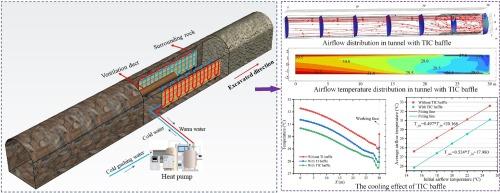Improving thermal environment and ventilation efficiency in high-temperature excavation tunnels via an innovative heat insulation and cooling baffle
IF 5.1
3区 工程技术
Q2 ENERGY & FUELS
引用次数: 0
Abstract
An increasing number of tunnels inevitably encounter high-temperature environments induced by elevated geotemperatures. The energy demand for ventilation and cooling in excavation tunnels increases significantly as the temperature of the surrounding rock increases, thereby hindering the sustainable exploitation of deep resources. This paper presents an optimization method for airflow organization in excavation tunnels that integrates thermal insulation and cooling (TIC) baffles. The proposed approach significantly improves the cooling effect of the auxiliary ventilation system while reducing energy consumption. This method offers the advantages of simplicity, convenience, and cost-effectiveness. A multifield coupling model using COMSOL software was developed and validated to analyze the system, and the application scenario was explored. Several ventilation scenarios were examined, highlighting that TIC baffles effectively reduce the heat release from the surrounding rock and lower the airflow temperature in personnel areas in the excavation tunnel. By implementing TIC baffles, the average airflow temperature in the excavation tunnel decreases by 1.5 °C to 1.8 °C, resulting in a saving of approximately 5.11 kW in cooling energy. Increasing the circulating water flow in the heat-exchange pipe of the TIC baffles or reducing the initial circulating water temperature can enhance the cooling capacity of the TIC baffles and lower the tunnel airflow temperature to a certain extent. The distance between the TIC baffles and surrounding rock significantly affects the airflow temperature between the left and right TIC baffles. An excessive length of TIC baffles (L > 7 m) leads to heat accumulation and high-temperature airflow in localized areas. In This study, a method for optimizing the thermal environment and saving energy in high-temperature excavation tunnels is proposed.

通过创新型隔热冷却挡板改善高温挖掘隧道的热环境和通风效率
越来越多的隧道不可避免地会遇到由地温升高引起的高温环境。随着围岩温度的升高,挖掘隧道的通风和冷却能耗需求也大幅增加,从而阻碍了深层资源的可持续开采。本文介绍了一种集成了隔热冷却(TIC)挡板的挖掘隧道气流组织优化方法。所提出的方法在降低能耗的同时,大大提高了辅助通风系统的冷却效果。这种方法具有简单、方便和成本效益高的优点。利用 COMSOL 软件开发并验证了多场耦合模型,对系统进行了分析,并探讨了应用场景。对几种通风方案进行了研究,结果表明 TIC 挡板可有效减少围岩的热量释放,降低开挖隧道内人员区域的气流温度。通过使用 TIC 挡板,挖掘隧道内的平均气流温度降低了 1.5 °C 至 1.8 °C,从而节省了约 5.11 千瓦的冷却能源。增加 TIC 挡板热交换管道中的循环水流量或降低初始循环水温度,可提高 TIC 挡板的冷却能力,并在一定程度上降低隧道气流温度。TIC 挡板与围岩之间的距离对左右 TIC 挡板之间的气流温度有很大影响。TIC 挡板过长(L > 7 m)会导致局部区域热量积聚和气流温度过高。本研究提出了一种在高温挖掘隧道中优化热环境和节约能源的方法。
本文章由计算机程序翻译,如有差异,请以英文原文为准。
求助全文
约1分钟内获得全文
求助全文
来源期刊

Thermal Science and Engineering Progress
Chemical Engineering-Fluid Flow and Transfer Processes
CiteScore
7.20
自引率
10.40%
发文量
327
审稿时长
41 days
期刊介绍:
Thermal Science and Engineering Progress (TSEP) publishes original, high-quality research articles that span activities ranging from fundamental scientific research and discussion of the more controversial thermodynamic theories, to developments in thermal engineering that are in many instances examples of the way scientists and engineers are addressing the challenges facing a growing population – smart cities and global warming – maximising thermodynamic efficiencies and minimising all heat losses. It is intended that these will be of current relevance and interest to industry, academia and other practitioners. It is evident that many specialised journals in thermal and, to some extent, in fluid disciplines tend to focus on topics that can be classified as fundamental in nature, or are ‘applied’ and near-market. Thermal Science and Engineering Progress will bridge the gap between these two areas, allowing authors to make an easy choice, should they or a journal editor feel that their papers are ‘out of scope’ when considering other journals. The range of topics covered by Thermal Science and Engineering Progress addresses the rapid rate of development being made in thermal transfer processes as they affect traditional fields, and important growth in the topical research areas of aerospace, thermal biological and medical systems, electronics and nano-technologies, renewable energy systems, food production (including agriculture), and the need to minimise man-made thermal impacts on climate change. Review articles on appropriate topics for TSEP are encouraged, although until TSEP is fully established, these will be limited in number. Before submitting such articles, please contact one of the Editors, or a member of the Editorial Advisory Board with an outline of your proposal and your expertise in the area of your review.
 求助内容:
求助内容: 应助结果提醒方式:
应助结果提醒方式:


